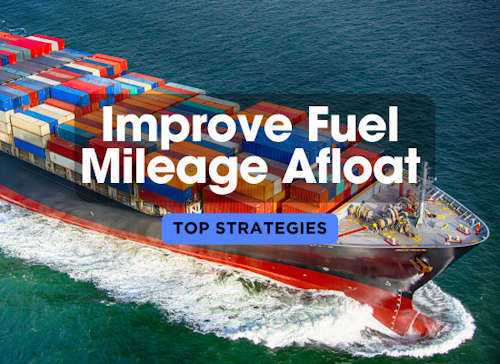Top Strategies to Reduce Fuel Consumption while Afloat

Fuel efficiency is a critical factor for maritime ships, influencing both operational costs and environmental impact. By making small adjustments and using onboard resources wisely, ship operators can reduce fuel consumption and save money—without having to stop or leave the water. This guide covers practical, actionable tips to improve fuel mileage while your ship is afloat.
1. Speed Reduction (Slow Steaming) 🚢💨
One of the most effective ways to reduce fuel consumption while afloat is by reducing the ship’s speed, also known as "slow steaming." The relationship between speed and fuel consumption is not linear—fuel use increases exponentially with speed. By reducing speed, even by a small amount, the ship can achieve significant fuel savings.
- Fuel Savings: For every 10% reduction in speed, fuel consumption can be reduced by 20-30%.
- Longer Voyage, Lower Costs: While it may increase voyage duration, the fuel cost savings often outweigh the added time.
- Engine Wear Reduction: Running the engines at lower speeds also reduces wear and tear, potentially lowering maintenance costs.
💡 Tip: Slow steaming is especially effective when cargo deadlines allow for flexible arrival times, maximizing savings without impacting schedules.
2. Trim Optimization ⚖️
Properly balancing the ship’s trim (the distribution of weight along the ship's length) while afloat can reduce water resistance and improve fuel efficiency. Trim optimization involves adjusting the ship’s ballast, cargo, and fuel levels to achieve the most efficient balance.
- Optimized Performance: Keeping the bow and stern properly balanced ensures smoother movement through the water, reducing drag.
- Use Trim Optimization Tools: Modern ships often have trim optimization software that helps the crew adjust the ship’s balance in real time for maximum efficiency.
- Up to 5% Fuel Savings: A well-trimmed ship can reduce fuel consumption by up to 5%, a meaningful reduction over long voyages.
⚙️ Tip: Continuously monitor and adjust trim during the voyage, especially after significant fuel consumption or changes in cargo weight.
3. Autopilot Optimization 🧭
Autopilot systems are commonly used on cargo and maritime ships to maintain a steady course, but many systems are not set up for fuel efficiency. By optimizing the autopilot settings, you can reduce unnecessary course corrections, which in turn lowers fuel consumption.
- Minimize Rudder Movements: Frequent rudder adjustments create additional drag, increasing fuel usage. Optimized autopilot settings help reduce these movements.
- Straight-line Efficiency: Maintaining a more direct course reduces the distance traveled, saving both time and fuel.
- Adapt to Conditions: Modern autopilot systems can be adjusted to adapt to various sea and wind conditions, further improving efficiency.
🛠 Tip: Regularly review and fine-tune your autopilot settings based on voyage conditions for maximum fuel savings.
4. Weather Routing 🌦️
Weather routing involves adjusting a ship’s course to avoid adverse weather, heavy seas, or strong headwinds. A well-planned route can significantly improve fuel efficiency by avoiding conditions that increase drag or require higher engine output.
- Avoid High Winds and Currents: Strong headwinds or currents increase the power needed to maintain speed, consuming more fuel. Adjusting the course to minimize these forces leads to better fuel mileage.
- Weather Forecasting Tools: Utilize modern weather forecasting software or routing services to choose the most fuel-efficient route based on real-time weather conditions.
- Fuel Savings: Ships that use weather routing can save up to 10% in fuel costs by taking smoother, more efficient routes.
🌍 Tip: Plan your voyage in advance with updated weather data to avoid storms or heavy seas, ensuring smoother sailing and lower fuel consumption.
5. Engine Load Optimization ⚙️
One of the most effective ways to improve fuel efficiency is by optimizing the engine load. Running the engine at an optimal load—typically around 70-85% of its capacity—ensures that fuel is burned efficiently. Overloading or underloading the engine can lead to inefficient fuel consumption.
- Avoid Low Load Operation: Operating an engine at very low loads for extended periods can lead to inefficient combustion, increasing fuel consumption and maintenance issues.
- Use Engine Monitoring Systems: Many modern ships are equipped with engine performance monitoring systems that provide real-time data, helping the crew optimize engine loads for efficiency.
- Maintain Ideal Engine Load: Consistently running the engine within the ideal load range ensures that fuel is used efficiently, leading to reduced fuel consumption and longer engine life.
🔧 Tip: Regularly monitor engine load and adjust to stay within the optimal range, especially during long, steady voyages.
6. Fuel Monitoring Systems ⛽
Fuel monitoring systems provide real-time data on fuel consumption, allowing the crew to make informed decisions to optimize fuel usage. These systems track the ship’s fuel consumption patterns and highlight inefficiencies that can be corrected during the voyage.
- Identify Inefficiencies: By using fuel monitoring systems, the crew can quickly identify areas where fuel is being wasted, such as improper engine load or suboptimal trim settings.
- Track Fuel Usage by Voyage Leg: Monitoring fuel consumption at different stages of the voyage (e.g., during port departure, cruising, and arrival) helps pinpoint opportunities for fuel savings.
- Immediate Adjustments: With real-time data, you can make on-the-spot adjustments to engine settings, trim, and speed to maximize fuel efficiency.
📊 Tip: Set up alerts on fuel monitoring systems to notify the crew when fuel consumption exceeds set limits, allowing for immediate action.
7. Air Conditioning and Ventilation Optimization ❄️🌬️
Air conditioning and ventilation systems onboard consume a significant amount of fuel, especially in hot climates. Optimizing these systems can lead to noticeable fuel savings, particularly during long voyages.
- Energy-Efficient Settings: Adjust air conditioning systems to run at optimal levels, using energy-efficient settings without compromising crew comfort.
- Ventilation Management: Ensure proper ventilation to reduce the need for excessive cooling. Well-ventilated spaces help keep temperatures more stable, reducing the workload on the air conditioning units.
- Scheduled Downtime: Turn off or reduce air conditioning in non-essential areas or during times when the ship is in cooler climates to save fuel.
💡 Tip: Consider using programmable thermostats or sensors that adjust cooling needs based on occupancy or outside temperature to avoid overuse.
8. Ballast Water Management 🌊
While afloat, the management of ballast water can have a significant impact on a ship’s fuel efficiency. The weight and distribution of ballast water directly affect the ship’s trim and stability, influencing how smoothly it moves through the water.
- Optimize Ballast for Stability: Ensure the ballast water is distributed in a way that enhances the ship's trim, reducing drag and improving fuel efficiency.
- Minimize Excess Ballast: Carry only the necessary amount of ballast water required for safe operation. Extra weight increases fuel consumption, so minimizing ballast reduces fuel use.
- Use Ballast Water Management Software: Many ships are equipped with ballast water management systems that calculate the optimal amount and distribution of ballast for fuel efficiency.
⚙️ Tip: Regularly review ballast water needs and adjust throughout the voyage, especially after fuel consumption or cargo unloading, to maintain optimal ship balance and fuel efficiency.
9. Avoiding Unnecessary Idling 🛑⚡
When a ship is anchored or waiting at port, it’s common to leave the engines running, but idling engines consume significant amounts of fuel unnecessarily. By reducing idling times, you can cut fuel consumption and extend engine life.
- Shut Down During Long Waits: If the ship will be idle for an extended period, shut down engines and switch to auxiliary power.
- Use Auxiliary Engines: Auxiliary engines consume less fuel compared to the main engines and can be used to power essential systems while the ship is anchored or waiting for docking.
- Port Power Options: Some ports provide shore power connections, allowing ships to use electricity from the grid rather than burning fuel while idle.
🔋 Tip: Establish guidelines for the crew to minimize engine idling and promote the use of more efficient auxiliary power when possible.
10. Efficient Cargo Loading and Stowage 📦⚖️
How cargo is loaded and stowed can have a major impact on fuel consumption. Proper distribution of cargo affects the ship’s balance, reducing drag and improving fuel efficiency during the voyage.
- Even Cargo Distribution: Properly balancing cargo between the bow and stern, as well as port and starboard, can ensure that the ship operates with optimal trim, reducing resistance and fuel consumption.
- Minimize Unnecessary Weight: Avoid carrying excess weight such as unnecessary equipment or supplies. Lighter ships require less power to move, directly reducing fuel consumption.
- Optimize Stowage Plans: Use cargo management software to plan the most efficient stowage layout, maximizing space while maintaining a balance that minimizes drag.
🚢 Tip: Coordinate with the loading team to ensure cargo is stowed in a way that maximizes fuel efficiency and stability throughout the voyage.
11. Power Management Systems 🔋💡
Efficient management of onboard power systems can lead to significant fuel savings. Many ships rely on generators to provide electricity for lighting, equipment, and other onboard systems, but these generators consume fuel.
- Optimize Generator Usage: Reduce the number of generators running at once or switch to more efficient auxiliary generators for non-essential loads, especially when the ship is in low-power situations, such as during port stays or at night.
- Use Energy-Efficient Equipment: Replace older, power-hungry equipment with energy-efficient alternatives, such as LED lighting or more efficient HVAC systems, which can significantly lower the power draw and fuel consumption.
- Automatic Power Management Systems: Many ships now have automatic power management systems that control generator loads based on demand, ensuring that generators are used only when necessary.
🔌 Tip: Implement automatic power management systems that monitor onboard electricity needs and adjust generator usage accordingly for more efficient fuel consumption.
12. Crew Training and Awareness 👨✈️📘
A well-trained crew can make a substantial difference in fuel efficiency. Training the crew on best practices for energy and fuel management while afloat ensures that every team member contributes to fuel-saving efforts.
- Fuel Efficiency Awareness: Provide training on how small adjustments—such as reducing speed, optimizing trim, and managing cargo loads—can result in fuel savings.
- Regular Updates: Keep the crew informed of the latest fuel-saving technologies and techniques, such as new software or adjustments to operational procedures.
- Incentives for Fuel Savings: Offer incentives or recognition programs for crew members who actively participate in fuel-saving initiatives, encouraging a culture of efficiency onboard.
🚢 Tip: Schedule regular training sessions on fuel efficiency best practices to ensure that all crew members are aligned in reducing fuel consumption.
| ShipUniverse: Summary | |
|---|---|
| Method | Description |
| Speed Reduction (Slow Steaming) | Reducing ship speed can lower fuel consumption by 20-30%. Slow steaming is ideal when voyage deadlines are flexible. It also reduces engine wear and tear, resulting in lower maintenance costs. |
| Trim Optimization | Proper trim balance reduces drag and improves fuel efficiency. Use trim optimization software to monitor and adjust the balance, potentially saving up to 5% in fuel. Continuously adjust trim after significant fuel consumption or cargo changes. |
| Autopilot Optimization | Optimizing autopilot settings minimizes rudder movements and ensures the ship maintains a more efficient, direct course. Regularly review settings to adapt to sea and wind conditions, helping save fuel. |
| Weather Routing | Avoid high winds and currents by planning routes using weather routing software. Ships that follow smoother, more efficient routes can save up to 10% in fuel costs. |
| Engine Load Optimization | Operating the engine at 70-85% load ensures optimal fuel efficiency. Regularly monitor engine performance to avoid low-load operation, which leads to inefficient combustion. |
| Fuel Monitoring Systems | Track real-time fuel usage and identify inefficiencies using fuel monitoring systems. Immediate adjustments can be made to optimize engine settings, trim, and speed based on the data. |
| Air Conditioning and Ventilation Optimization | Adjust air conditioning settings for efficiency, ensuring proper ventilation to reduce cooling needs. Turn off air conditioning in non-essential areas to save fuel. |
| Ballast Water Management | Optimize ballast water distribution to maintain efficient trim. Minimize unnecessary ballast to reduce weight and fuel consumption. |
| Avoiding Unnecessary Idling | Minimize engine idling by switching to auxiliary power during long waits at port or while anchored. Shore power connections can also reduce fuel usage while idle. |
| Efficient Cargo Loading and Stowage | Properly balance cargo to ensure optimal trim, reducing drag. Avoid overloading and use cargo management software to plan the most efficient stowage layout. |
| Power Management Systems | Reduce the number of generators running at once and use energy-efficient equipment. Automatic power management systems can adjust generator usage based on demand. |
| Crew Training and Awareness | Ensure the crew is trained in fuel-saving techniques like speed reduction, trim optimization, and efficient cargo management. Regular updates and incentives can encourage a fuel-efficient culture. |

Do you have a Maritime Product or Service that may be of interest to Shipowners? Tell us about it here!
Do you have feedback or insights? Please reach out to editor @ shipuniverse.com



